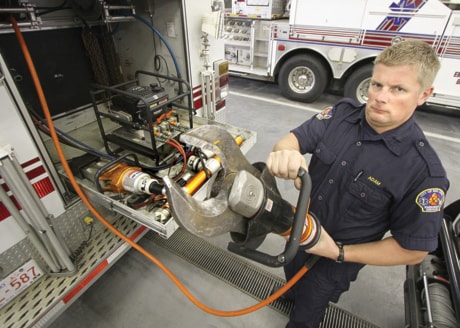Never mind the fancy laser-guided hazmat detectors or the brutish 200,000 pounds-per-inch vehicle cutters.
One of the most valuable recent advances in Red Deer Emergency Services is the continual link provided by the little black tags on every fire-medic’s turn-out gear to the platoon chief’s computer.
Inside the tag is a computer chip, which will soon allow the platoon chief to monitor his or her crew’s safety while they’re fighting a structure fire or dealing with some other emergency.
“It’s technology that can save firefighters’ lives,” Red Deer fire-medic Justin Andrew said on a tour of the downtown fire hall’s newest equipment acquisitions.
The kinks are still being ironed out and right now the department is leaning on its old method, where a board is set up at the scene of a fire and the fire-medics going into a burning structure signify their movement using colour-coded pieces of plastic.
Deputy chief of operations Mike Meagher said they’d like to have the new system completely in place by the end of summer but they needed to purchase a mobile electronic device first so the platoon chief could track crew members from the appropriate place at the entrance to a building.
“It’s just so important that we can’t put something like that in place until we’re absolutely sure that we’ve got it down pat,” said Meagher. “That’s what keeps track of people in harm’s way.”
The electronic tag allows the platoon chief to monitor who is using a breathing apparatus and how much air-time they have left. There’s also an alarm capacity to alert the platoon chief to any man down.
The newest and most expensive piece of equipment in the hazmat trailer at the downtown fire hall is an Ahura FirstDefender. This device rings in at about $30,000 and if ever actually used, will allow fire-medics to identify with lasers any mysterious substance suspected to be dangerous, be it anthrax or baking powder.
“A lot of this stuff, hopefully it’s never used, other than in training,” Andrew said. “When we do use it, it basically pays for itself flat out. Just like that.”
The advent of new designs and tougher materials used in the construction of cars and trucks has Emergency Services upgrading kits of hydraulic rescue tools, commonly known as the Jaws of Life.
The only new purchase so far is a $14,000 cutting tool that can break through metal with 200,000 pounds-per-square inch of force, an upgrade from the old 50,000 pounds-per-square inch cutters.
One of the biggest changes underway at local fire halls is the implementation of a computer system in ambulances and fire trucks that allows emergency first-responders access to things like maps of the city (although they aren’t yet GPS enabled), directories of automobile makes and models (so that, for instance, hybrid vehicles and their potentially dangerous electrical systems can be identified), and even pre-plans for any high-hazard building, like a hospital.
Through these pre-plans, fire-medics using the Auto-CAD, or Computer Aided Dispatch, system will have access to building schematics, including danger areas and emergency contact information, en route to the call.
Each Auto-CAD unit cost about $7,500.
“Every facet of our job has seen technological change,” said Andrew, who has been with Red Deer Emergency Services for eight years. “With the growing population and the growing demand for our service, we have to develop what we do.”
mgauk@www.reddeeradvocate.com
